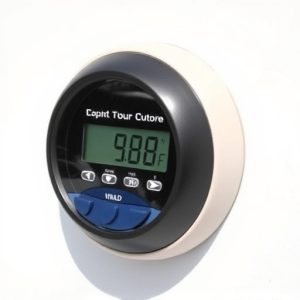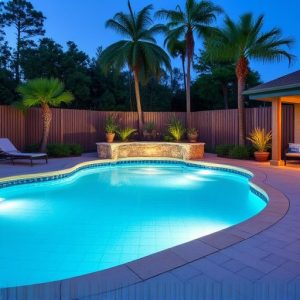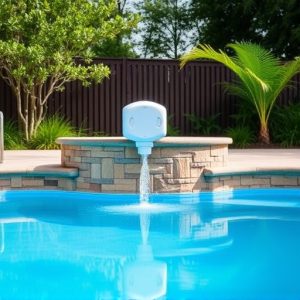Inground Pool Safety: Essentials of Alarm Systems and Maintenance
Swimming pool alarms are a critical safety feature for inground pools, essential for preventing uni…….
Swimming pool alarms are a critical safety feature for inground pools, essential for preventing unintended drownings and safeguarding against unauthorized access, particularly where children are present. These alarms come in various technologies, including motion sensors, surface displacement monitors, and underwater detectors, and should be chosen based on the specific size, shape, and usage of your pool to ensure comprehensive coverage. It's important to opt for systems that comply with CPSC standards or are endorsed by the Pool Safely campaign for reliability and sensitivity. A robust safety strategy includes not only the installation of these alarms but also secure fencing, clear signage, consistent maintenance, and integration with home security systems for remote monitoring. Regular testing and upkeep are crucial for maintaining alarm effectiveness. Homeowners must adhere to local legal requirements and follow best practices for selecting, placing, and maintaining their swimming pool alarms, which play a pivotal role in pool safety alongside other preventive measures. These alarms should be audible from the home and the surrounding area and tailored to the unique characteristics of the inground pool they protect. By following these guidelines, swimming pool alarms can significantly enhance the safety of inground pools for all users.
When it comes to safeguarding your inground pool, investing in a reliable swimming pool alarm is paramount. This article delves into the critical aspects of choosing and maintaining an effective pool alarm system. We’ll guide you through understanding how these alarms work, their key features for optimal safety, and the importance of regular upkeep. Additionally, we’ll help you navigate the legal requirements for inground pool safety alarms across different regions. Ensuring your family’s protection, while adhering to local regulations, is not just a precaution—it’s an essential responsibility for pool owners.
Understanding Swimming Pool Alarms for Inground Pools: A Safety Primer
When it comes to safeguarding your inground pool, installing a reliable swimming pool alarm is a critical step in preventing accidental drownings. These alarms are specifically designed to detect unauthorized or unexpected entries into the water, providing an audible warning that can alert homeowners and guardians to potential hazards. The technology behind these devices varies, with some utilizing motion sensors to identify when someone has entered the pool area, while others monitor for changes in water surface displacement caused by movement. It’s crucial to select a model that aligns with your pool’s dimensions and usage patterns to ensure optimal performance and coverage.
For the most effective protection, consider alarms that conform to the standards set forth by the Consumer Product Safety Commission (CPSC) or those that are certified by organizations such as the Pool Safely campaign. These certifications indicate that the alarm has been rigorously tested for reliability and sensitivity, ensuring it will perform as intended in real-world conditions. Additionally, integrate your pool alarm with a comprehensive safety plan that includes secure fencing, clear safety signage, and regular maintenance to create a layered approach to safety. This multifaceted strategy is the most effective way to ensure that your inground pool remains a source of fun rather than a potential risk. Remember to regularly test and maintain your swimming pool alarms for inground pools to guarantee their functionality at all times.
Key Features of Effective Inground Pool Alarms
When it comes to ensuring safety around inground pools, investing in reliable swimming pool alarms is a critical step for homeowners and public facilities alike. Effective alarms for inground pools serve as a first line of defense against accidental or unauthorized access, which can be particularly hazardous, especially for children who may lack the swimming skills to stay afloat or avoid danger. A key feature of these alarms is their capacity to detect any movement within the immediate vicinity of the water’s edge. They are designed with sensors that can distinguish between typical pool use and potential intrusions, triggering an audible alert when a person enters the pool area unexpectedly.
Moreover, inground pool alarms come equipped with various technologies such as magnetic safety covers, motion-detection systems, and state-of-the-art water surface detectors that can be placed on the ledge or submerged in the water. These devices are often interconnected with a home security system for remote monitoring, ensuring that even when owners are not physically present, they can be alerted instantly to any unauthorized activity near the pool. It’s important to select alarms that comply with local and national safety standards and regulations, which may include specific decibel levels for audibility, tamper resistance, and ease of use for maintenance purposes. The integration of these smart features into inground pool alarms ensures a higher level of protection, making them indispensable tools for safeguarding against potential dangers in and around swimming pools.
The Importance of Regular Maintenance and Testing of Your Inground Pool Alarm System
Regular maintenance and testing are indispensable practices for ensuring the safety and efficacy of inground pool alarms. These systems, which serve as a critical line of defense against unauthorized access or accidental drownings, rely on consistent functionality to provide timely warnings. Homeowners with swimming pool alarms for inground pools should establish a routine schedule for inspection and upkeep. This involves verifying that all components, including sensors, speakers, and connectors, are operational and free from corrosion or damage that could impair their performance.
Testing the alarm system regularly not only confirms its responsiveness but also familiarizes pool users with its sound and functionality. It is advisable to simulate an alarm event periodically, ensuring that it activates as intended and that alerts reach designated responsible parties promptly. This practice aids in identifying any potential malfunctions before they could lead to a critical failure at a time when safety is most needed. Additionally, keeping the system’s power supply uninterrupted and maintaining clear lines of communication for alarm notifications are vital steps in pool safety protocols. Regular maintenance and testing of inground pool alarms are integral to the overall safety regimen of any residential swimming pool setup, providing peace of mind and ensuring that the system stands as a reliable sentinel around your pool.
Selecting the Right Alarm for Your Family's Needs and Inground Pool Setup
When selecting a swimming pool alarm for your inground pool, it’s crucial to consider the specific needs and setup of your family’s swimming area. The ideal alarm will depend on factors such as pool size, shape, and how it integrates with your home’s safety system. For instance, surface motion detectors can be effective in larger inground pools, as they are sensitive to movements at the water’s surface, which could indicate an unauthorized person entering the pool. These alarms work by using sensors that trigger an alarm when motion is detected, providing real-time notifications to ensure immediate response. On the other hand, for safety-conscious families looking for a more advanced solution, underwater motion detectors offer an added layer of protection by being less susceptible to false alarms from wind-induced waves or animals. These alarms are placed at the deep end of the pool and can detect subtle changes in the water’s surface, distinguishing between human movements and natural occurrences.
Additionally, when choosing an inground pool alarm, it’s essential to consider compatibility with existing pool features and landscaping. Some alarms come with float-type sensors that are easily deployable across any inground pool, while others may require professional installation for optimal performance. It’s also important to select a system with a sound output that is audible within your home and yard, ensuring that the alarm can be heard by all members of your household. By carefully evaluating these aspects, you can find a swimming pool alarm that aligns with your family’s safety requirements and complements your inground pool setup, providing peace of mind and enhancing overall pool security.
Legal Requirements and Best Practices for Inground Pool Safety Alarms in Different Regions
When installing swimming pool alarms for inground pools, adherence to legal requirements and adherence to best practices are paramount for ensuring safety. These alarms serve as a critical first line of defense in preventing accidental drownings by alerting homeowners and authorities immediately when an individual, particularly a child, falls into the pool unsupervised. Legislation varies by region, with some areas mandating specific types of alarms or their use as part of a layered approach to pool safety. For instance, some regions require audible pool alarms that are both visible and accessible, ensuring they can be heard from the home or a nearby dwelling. These devices often integrate sensors that detect motion or the presence of a person in the water, triggering an alarm that alerts individuals within proximity to take immediate action.
Best practices for inground pool safety alarms extend beyond legal compliance and include the regular testing and maintenance of these systems. It is recommended that pool owners test their alarms monthly to ensure they are functioning correctly. Additionally, the placement and selection of alarms should be based on the pool’s specific layout and usage patterns. For example, above-water motion sensors may be more effective for pools with high traffic, while underwater pressure-based sensors might be ideal for pools used primarily by swimmers. It is also crucial to consider the integration of these alarms with other safety measures, such as secure fencing and self-closing gates, to create a comprehensive safety system that provides multiple barriers to unsupervised access. By staying informed about local regulations and following industry best practices for swimming pool alarms for inground pools, homeowners can significantly enhance the safety of their pool environments.


